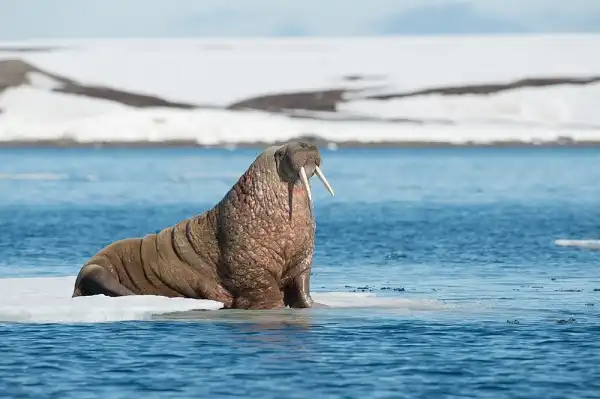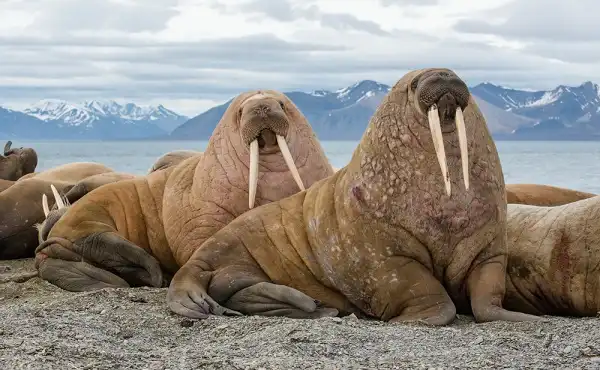Are you familiar with walrus? This lumbering creature of the sea has fascinated people for centuries, and now it’s time to learn more! From its iconic tusks to its unique lifestyle in cold northern waters, there is much to discover about this majestic marine mammal. In this blog post, we’ll dive into the secrets of the walrus – exploring where they live, what they eat, and how their anatomy has changed over time. Get ready to leave the land and join us on an adventure across icy seas – it’s sure to be a fascinating journey!

Walrus Description
The walrus is a large, flippered marine mammal, closely related to the seal family. These intelligent animals are easily recognized by their unique ivory tusks, which can be up to one meter in length. Walruses have thick layers of blubber and a streamlined body shape that helps them swim quickly under the sea. They also have four short flippers that act as paddles while swimming, enabling them to turn and maneuver swiftly in cold ocean waters. They vary in color from yellowish-brown to gray or black depending on their age and gender. Male walruses are often darker than females, with more pronounced tusks and longer whiskers. The males also develop thick bumps called “bosses” on their shoulders during the mating season as a display of dominance over other males.
Walrus Habitat
Walruses live in cold waters near shorelines and pack ice in both the Pacific and Atlantic oceans, but they migrate south during winter months when pack ice recedes farther north. They typically inhabit shallow habitats such as estuaries, bays, and sea ice shelves. Walruses prefer colder temperatures, usually around 32 degrees Fahrenheit (0 degrees Celsius), but can also be found in warmer regions like Alaska that have milder weather. Walruses are found mainly in the Arctic Ocean along the coasts of Russia, Greenland, Canada, Alaska, Norway, and Denmark. However, some walruses have been spotted as far south as California’s Bering Strait in recent years due to global warming and melting polar ice caps. In addition to their native Arctic habitat, walrus populations have increased significantly over the last few decades due to conservation efforts by zoos and aquariums around the world. This has allowed them to expand their range beyond their traditional habitats into new areas such as northern Europe.
Walrus Diet
Walruses primarily feed on bivalve mollusks such as clams, mussels, and snails, which they dig out of the sand with their tusks or vacuum up with their powerful snouts. They also eat fish, small crustaceans, sea stars, and worms, and occasionally scavenge on carcasses of larger animals like whales or seals. Walruses are highly opportunistic feeders capable of adapting their diet according to season and location—they consume more fish during summer when they move into shallow waters near coastal areas to feed. Walruses have strong flexible lips that help them suck the flesh out of clam shells and other bivalves with ease. Their large front flippers act as shovels while searching for prey on sandy seabeds, allowing them to uproot clams and mussels from the ocean floor. To conserve energy during digestion they often swallow their prey whole instead of chewing it.

Walrus Size
Walruses are large marine mammals, typically weighing anywhere from 800 to 1,800 lbs (360 to 816 kg). Males tend to be much larger than females and can grow up to 11 feet (3.4 meters) long and 4 feet (1.2 meters) wide! Female walruses typically measure around 7 feet (2.1 meters) long and 3 feet (0.9 meters) wide. The largest recorded walrus weighed an impressive 4,000 lbs (1,814 kg)! Walruses have thick layers of blubber which help them stay warm in the icy cold waters of the Arctic. This blubber ranges between 7-12 inches thick in males and 5-7 inches thick in females—this helps regulate their body temperature no matter how cold or warm the water gets. In addition to their size, walruses are also known for their large tusks which grow up to 3 feet long, and are used for a variety of purposes ranging from breaking open shellfish to defending against predators such as polar bears or killer whales.
Walrus Lifespan
Walruses typically live between 25 to 30 years in the wild. In captivity, these marine mammals can survive up to 50 years, with one female living as long as 43 years. Walruses are typically slow to mature, and it isn’t until they turn 3-4 years that they become sexually mature enough for reproduction. Walruses have a unique aging process where their tusk teeth grow constantly throughout their life. At birth, walruses have short and narrow tusks, but by the age of 10-15, they reach full length and thickness. By analyzing the layers of ivory on their tusks, researchers can accurately estimate the age of individual walruses within a few years. Despite their large size and impressive lifespan, walrus populations are currently at risk due to numerous environmental factors such as climate change and overfishing near feeding areas. To help conserve these animals, various governments around the world have enacted laws to protect walrus habitats and limit commercial activities in heavily trafficked areas.
Walrus Behavior
Walrus’ behavior is quite varied and complex. These marine mammals are social animals, living in large groups that can number anywhere from a few hundred to over 10,000 individuals. Within these large groups, walruses form smaller pods of 10-15 individuals and use various vocalizations to communicate with one another. They engage in a variety of playful activities such as body-slamming and tusk wrestling—behaviors thought to help establish dominance as well as strengthen social bonds between members of the pod. Walruses also have an impressive ability to dive deep underwater in search of food. Males are capable of diving up to 800 feet (244 meters) below the surface, while females typically stay closer to the shoreline—diving down only around 200 feet (61 meters). During these dives, walruses can remain submerged for up to 30 minutes while searching the seafloor for clams and other small prey items.

Walrus Speed
Walruses are known for their slow and lumbering gait on land, but they can be surprisingly swift swimmers in the ocean. While on land, walruses typically move at speeds of up to 3 miles per hour (4.8 kilometers per hour). However, when in water they are capable of reaching speeds up to 6 mph (9.7 kph), with bursts of speed as high as 12 mph (19.3 kph) when they need to escape from a predator or reach a food source quickly! In addition to impressive speed, walruses also possess incredibly strong endurance and lung capacity—able to stay submerged underwater for up to 30 minutes searching for food before resurfacing for air. This is due to their specialized circulatory system which allows them to store oxygenated blood in their muscles and organs while underwater, giving them extra energy reserves that enable them to swim long distances without getting tired easily.
Walrus Hunting
Walrus hunting is an important aspect of walrus behavior, as these large aquatic mammals rely heavily on their hunting skills to find food. Walruses typically hunt alone or in small groups, using their extended vibrissae to detect and locate potential prey items such as clams, mollusks, and other small marine creatures living on the seafloor. They are also known to use their powerful tusks to break open shells or excavate through sand and mud in order to uncover hidden prey. Once a walrus finds its target, it will use its strong flippers and webbed feet to help propel it towards the prey, sometimes propelling itself great distances underwater before finally snatching its meal with its long curved tusks. Walruses can even carry their prey back up onto the shore, making them one of the few marine mammals capable of hunting both above and below water!
Walrus Reproduction and Life Cycle
Walruses have an interesting life cycle and reproduce in much the same way as other marine mammals. The average gestation period for a baby walrus is 11 months, with females giving birth to a single calf—and sometimes twins—once every 2 or 3 years. After they are born, calves nurse from their mother’s milk for up to six months and may remain with her for two years or more. The walrus population is not without its threats, however; climate change is causing sea ice to melt, making it harder for the species to find food and reproduce successfully. Additionally, they are often targets of human hunting practices both legal and illegal, which can further reduce their numbers in the wild.
Fortunately, conservation efforts are being made to help protect walruses from these threats and ensure their long-term survival. During their lifetime, the walruses will form strong bonds with other members of their species and also display mating behaviors such as vocalizations and displays of affection. When a female is ready to mate, she will find a group of males who are likely to be her most suitable mates and begin courting them. The male then uses his tusks to show off his strength and vigor in hopes of gaining the female’s attention. If successful, he will take her to a private spot on the shore where they can mate.

Conclusion
Walrus speed, endurance, and hunting are all important adaptations that help these large aquatic mammals thrive in harsh Arctic environments. Walruses are capable of remarkable speeds when moving through the water, and possess an impressive lung capacity to stay submerged underwater searching for food. They also rely heavily on their hunting skills to find prey—and use their tusks for both offensive and defensive purposes when necessary.
Frequently Asked Question


